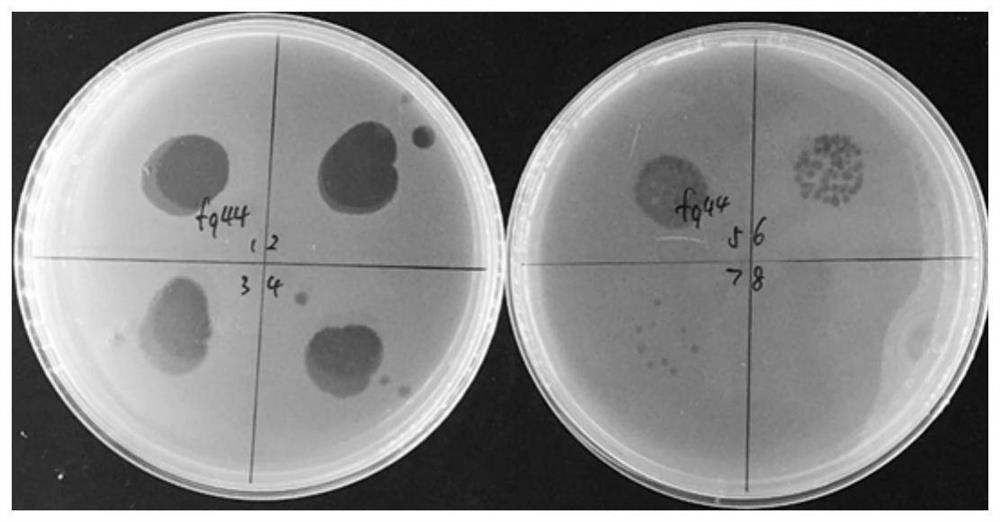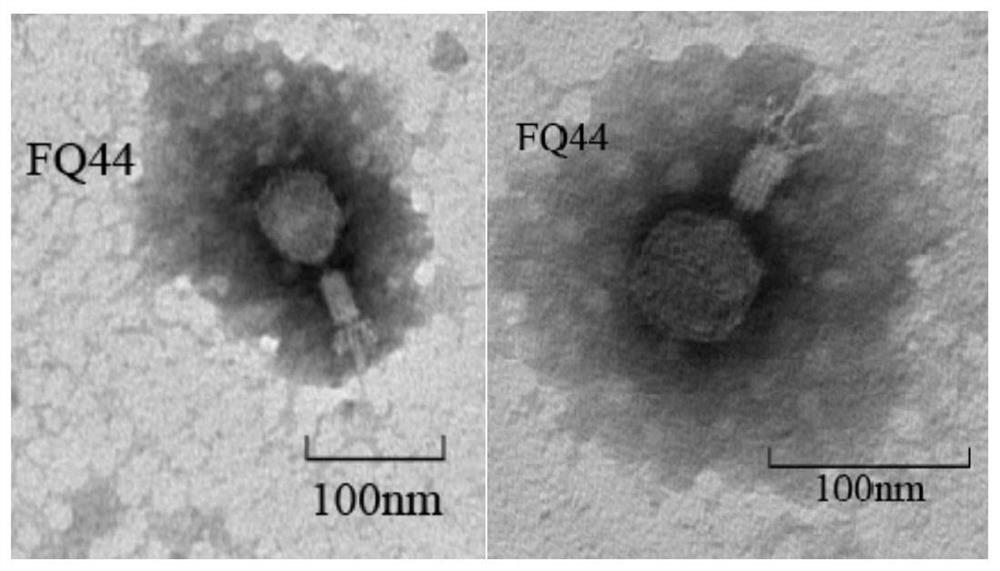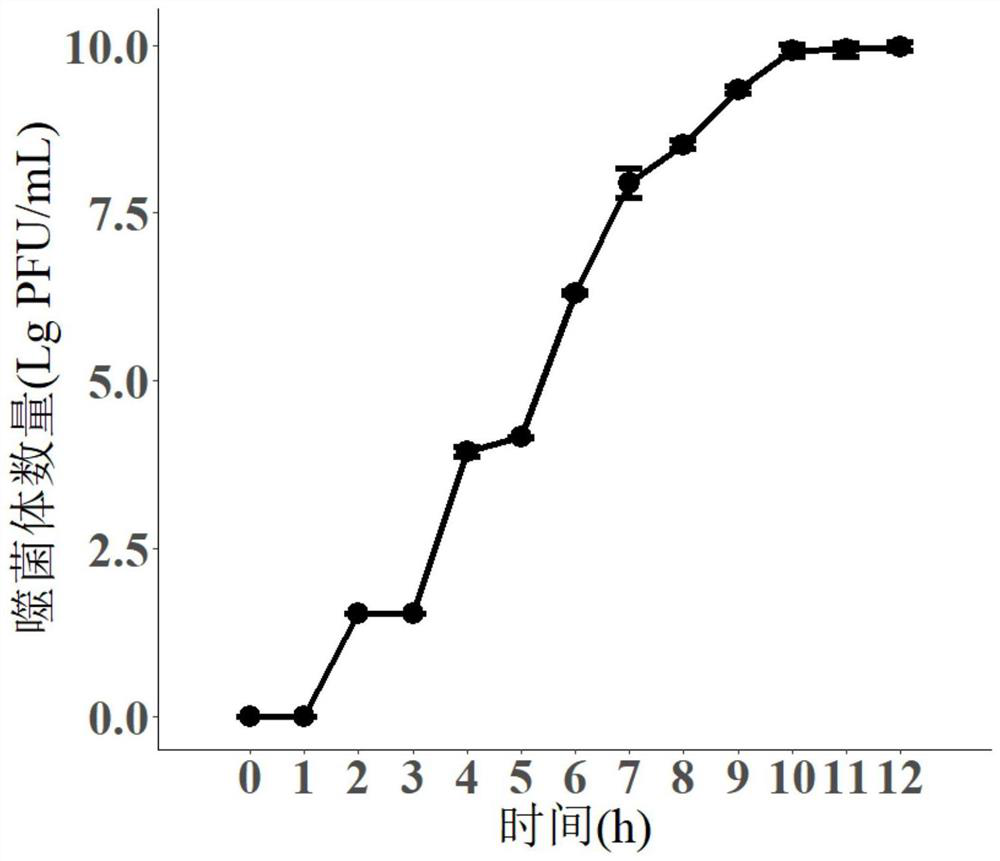A lytic phage and its application in the prevention and control of tobacco soil-borne bacterial wilt
A bacteriophage and bacterial wilt technology, applied in the field of microorganisms, can solve the problems of polluting the environment, destroying the stability of soil microorganisms, affecting the quality of tobacco, and achieving the effect of inhibiting the occurrence of bacterial wilt and reducing disturbance.
- Summary
- Abstract
- Description
- Claims
- Application Information
AI Technical Summary
Problems solved by technology
Method used
Image
Examples
Embodiment 1
[0034] Isolation of Ralstonia solanacearum
[0035] Take 1 g of tobacco plant rhizosphere soil sample collected from the bacterial wilt disease incidence area in Yunnan Province, and put it into a sterilized 50 mL conical flask containing 9 mL of deionized water (water-soil ratio 1:9). Put the Erlenmeyer flask into a shaker at 30°C and 150-180 rpm for 30-60 min to obtain a soil suspension. Take the soil suspension for gradient dilution. The specific method is: take 100 μL of soil suspension, add it to a centrifuge tube containing 900 μL of sterile water, and vortex; the dilution gradient is 10 -1 of soil suspension, repeat this step for gradient dilution to obtain a dilution gradient of 10 -2 , 10 -3 , 10 -4 soil suspension. Take 100 μL of the soil suspension of each dilution gradient and apply it to the semi-selective M-SMSA solid medium of R. solanacearum. Three replicates were set for each dilution gradient. The plate was placed upside down in a constant temperature i...
Embodiment 2
[0054] Phage electron microscope observation
[0055] 1. Select the phage FQ44 to be observed and the corresponding host R. solanacearum YNYC-23.
[0056] 2. Prepare a double-layer plate of R. solanacearum according to the method in Example 1, drop 150 μL of phage suspension on the plate, and place it in a 30°C constant temperature incubator for 12-24 hours until plaques appear.
[0057] 3. Add a small amount of sterile ddH to the place where plaques appear 2 O (500 ~ 1000μL), let stand for about 1h, during which time it should be shaken gently for many times, so that the phage floats from the agar to the water surface.
[0058] 4. Take an appropriate amount of phage suspension, negatively stain with 2% phosphotungstic acid dye solution, take out from the dye solution after about 90s of staining, and air dry naturally at room temperature.
[0059] 5. Use transmission electron microscope to observe the morphology of phage.
[0060] Depend on figure 2 It can be seen that th...
Embodiment 3
[0062] Phage optimal multiplicity of infection determination
[0063] The multiplicity of infection (MOI) refers to the ratio of the number of phage to the host bacteria before the phage adsorbs and infects the host bacteria. The optimal multiplicity of infection is the MOI that yields the highest progeny phage yield.
[0064] With reference to the method in Example 1, the bacterial liquid of R. solanacearum YNYC-23 in logarithmic growth phase was obtained, and the bacterial liquid of R. solanacearum was OD with sterile water. 600 The value is adjusted to 0.5. The phage suspension purified in Example 1 was added dropwise to the NA liquid medium containing Ralstonia solanacearum, and incubated at 30°C with shaking at 170 rpm for 12 hours; the culture medium was centrifuged at 13,000 rpm for 3 minutes at room temperature, and the supernatant was taken and filtered with a 0.22 μm membrane. Filter to obtain a phage suspension; adjust the titer of the phage suspension to 1×10 wit...
PUM
 Login to View More
Login to View More Abstract
Description
Claims
Application Information
 Login to View More
Login to View More - R&D
- Intellectual Property
- Life Sciences
- Materials
- Tech Scout
- Unparalleled Data Quality
- Higher Quality Content
- 60% Fewer Hallucinations
Browse by: Latest US Patents, China's latest patents, Technical Efficacy Thesaurus, Application Domain, Technology Topic, Popular Technical Reports.
© 2025 PatSnap. All rights reserved.Legal|Privacy policy|Modern Slavery Act Transparency Statement|Sitemap|About US| Contact US: help@patsnap.com



